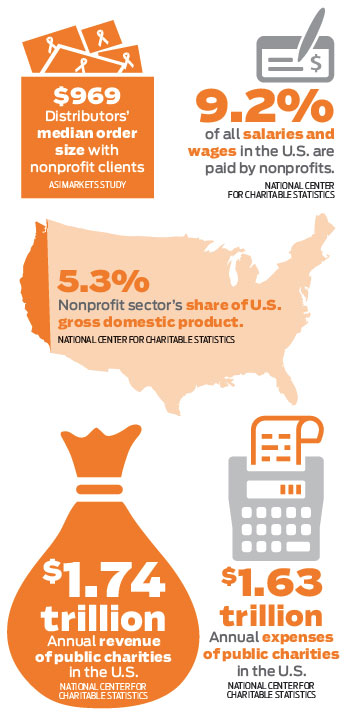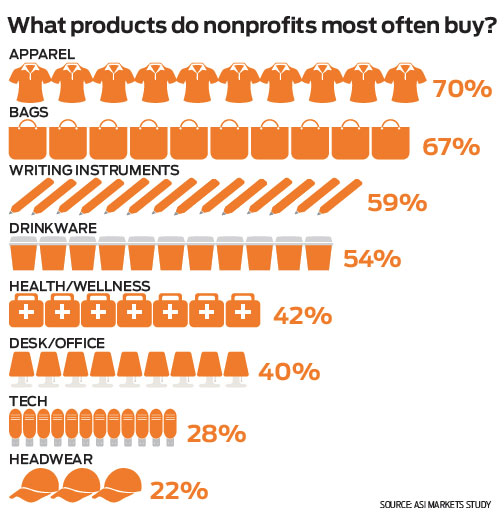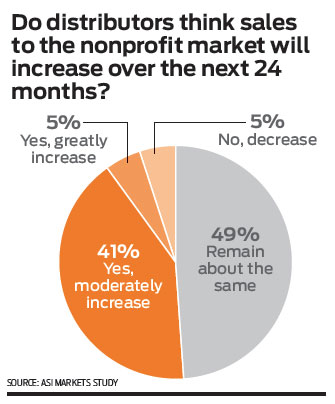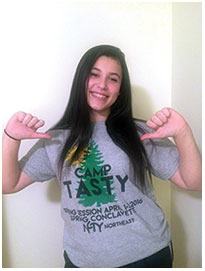July 13, 2016
Why the Nonprofit Market Slipped In 2015
After a strong few years, ad specialty sales to the nonprofit sector decreased in 2015. Will the slide continue, or is a rebound inevitable?

Sometimes, the numbers tell an uncomfortable tale.
>> Related: 9 strategies to spark sales for nonprofits
In 2014, distributors’ sales to nonprofits totaled $1.57 billion. A year later, that annual revenue tally declined to $1.13 billion. While 2015’s sales to the sector exceeded totals in 2013 ($881.5 million) and 2012 ($814.8 million), the retreat from 2014’s high went against the grain of distributors’ overall 3.4% revenue increase last year. “There are probably a thousand factors that come into play for why the decline occurred,” says Rick Cohen, director of communications and operations at the National Council of Nonprofits. “But there are a few broad trends that probably have particular correlation.”
In this nonprofits market spotlight, Advantages explains potential reasons for the 2015 sales slip, while also providing nine strategies to help fuel a revenue turnaround.

3 Reasons 2015 Sales to Nonprofits Declined
Nonprofits are under pressure to reduce expenses: The impetus is, in part, a result of media reports that have characterized certain nonprofits as spending too much on fundraising and overhead, including employee salaries. Rick Cohen, of the National Council of Nonprofits, believes some charities could be responding to the backlash by cutting promotional costs – something he feels is quite damaging in the long term. “Nonprofits are being penalized for doing marketing to bring in revenue to support their missions,” he says. “Because they’re under pressure to reduce the fundraising ratio, they could be spending less of their budget on materials associated with fundraising,” like branded merchandise.
Budget strain: Nationwide, some nonprofits are grappling with the challenge of meeting increased demand with budgets that are stretched to snapping. While individual giving, which Cohen says accounts for nearly 10% of nonprofit revenue, has crept back up toward pre-recession levels, grants and contracts – about a third of revenue – have yet to recover. In some cases, financially strapped state and local governments are cutting nonprofit allocations or even failing to provide the full amount of cash to support a service they’ve contracted a nonprofit for. “Nonprofits are working hard to make up the funding gap,” but might be stretched as far as they can go, says Cohen. This could result in less money to spend on advertising specialties.
Increased Competition: The number of nonprofits is growing, up from approximately 1.44 million in 2012 to 1.57 million this year. While that certainly means more potential clients for distributors, it also means more organizations trying to draw from the same pool of dollars. “There is a lot of competition,” says Michael Nilsen, vice president of public policy at the Association of Fundraising Professionals. And, as Cohen adds, “while competition can drive innovation and achievement, it also can result in having two fairly weak organizations with the same mission just trying to survive as opposed to having one strong organization.” Struggling nonprofits could be more reluctant to invest heavily in promotional products.

Don’t Give Up on Nonprofits
While the nonprofit sector is wrestling with challenges, the market is still a viable target for distributors. For one thing, nonprofits remain a top seven market for branded merchandise sales. Significantly, the $1.13 billion generated in 2015 was on par with the median annual sales result distributors produced within the nonprofit market between 2008 and last year. “Many nonprofits certainly have money to spend,” says Ann Patton, owner of Proforma Buckeye (asi/491480).
Patton would know. She’s experienced in working with a variety of nonprofits, including an organization that provides mental health services. By building a tight relationship with the client and offering fresh ideas, Patton has become an important partner. In fact, Proforma Buckeye typically earns $15,000 to $25,000 in annual sales with the account.
“We’ve designed their logo, done their internal and external signage, and provided them with their printed business documents and promotional products,” says Patton, who handles everything from swag for trade shows to wearables for an annual golf fundraiser for the client. “If you go in with ideas that help them fundraise and better serve their clients, you can have success with nonprofits.”

Case Study
A Personal Touch
 Having formerly worked at nonprofits, Nina Shatz is skilled at building business with organizations in the sector. One of the strategies the brand development director at HALO Branded Solutions (asi/356000) uses to stimulate sales is to identify opportunities with nonprofits she’s currently connected to in her personal life. The approach helps keep her revenue stream flowing – and leaves her feeling good, knowing that she’s helped an organization she cares about.
Having formerly worked at nonprofits, Nina Shatz is skilled at building business with organizations in the sector. One of the strategies the brand development director at HALO Branded Solutions (asi/356000) uses to stimulate sales is to identify opportunities with nonprofits she’s currently connected to in her personal life. The approach helps keep her revenue stream flowing – and leaves her feeling good, knowing that she’s helped an organization she cares about.
Recently, Shatz provided 300 Bluetooth speakers to a nonprofit that gives financial assistance to underprivileged youth, enabling them to participate in sports, camp, arts programs and more. Through her hands-on volunteering with the organization, Shatz asked the woman organizing a black-tie gala fundraiser about a giveaway. It turned out the woman had been so busy, she hadn’t considered offering attendees a gift until Shatz inquired. Regardless, she now wanted something, and asked Shatz for help, setting the stage for a mutually beneficial sale. “The speakers were very well received,” says Shatz, noting that the items were branded with the nonprofit’s name and the date of the event.
In a separate deal, Shatz provided about 500 T-shirts for the reform synagogue she attends. Shatz knew the synagogue would need a giveaway – likely tees – for the nearly 500 teens coming to a regional youth group event that it was hosting. Acquainted with the woman organizing the event, Shatz casually approached her to ask about the planned gift. The conversation resulted in the woman inviting Shatz to provide a quote for shirts. Helped by her personal ties to the synagogue, Shatz earned the business. “The synagogue and the kids loved the shirts, and my daughter – who is in the youth group – was proud that her mom made the tees,” Shatz says.
Christopher Ruvo is senior writer for ASI’s Advantages magazine. Tweet: @ChrisR_ASI. Contact: cruvo@asicentral.com